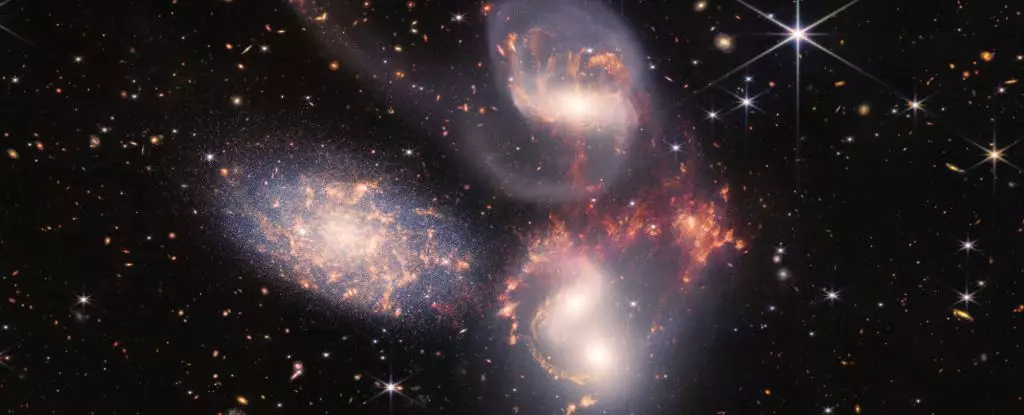In the vast expanse of space, 290 million light-years from our home planet, a grand spectacle unfolds—an intricate interplay among four galaxies known collectively as Stephan’s Quintet. While visually they seem to be clustered together, one member, noted as the fifth galaxy, is actually a distant interloper, situated far enough away not to engage in the gravitational ballet. This cosmic group has long fascinated astronomers, providing a tangible glimpse into how galaxies interact, collide, and ultimately merge into larger structures. The discoveries emerging from this region offer groundbreaking insights into the processes that govern galaxy formation and evolution.
Understanding Galaxy Interactions
The heart of the action in Stephan’s Quintet comes from the lightning-quick movement of one galaxy, NGC 7318b, which is barreling into the surrounding environment at speeds of 3.2 million kilometers per hour (approximately 2 million miles per hour). The consequences of this dramatic encounter are stunning, as the galaxy’s rapid motion creates a shock front that illuminates the region akin to a colossal sonic boom. Astrophysicist Marina Arnaudova from the University of Hertfordshire describes this event as not simply a spectacle but as a revival of complex dynamical activity within the galaxy group, raising important questions about the interactions at play.
The Dynamics of Galactic Evolution
Since its discovery in the 19th century, the quintet’s complexity has captivated scientists, leading them to probe into the historical narrative of cosmic collisions. As galaxies weave through space, their gravitational interactions can strip gas and debris from their bodies, creating clouds of material that exist between them—leftovers from a grand cosmic feast. Observations derived from the William Herschel Telescope’s WEAVE spectrograph shed light on these intricate developments by detecting the properties of gas that is now in a state of flux due to ongoing interactions.
The collision’s dramatic results emerge as the shock wave travels through variably heated pockets of gas. Where the shock encounters cold gas, it exerts energy that is several times the speed of sound in that cosmic medium, tearing apart atomic structures and leaving glowing trails of charged particles as evidence of its violent passage. Conversely, when the shock wave encounters hot gas, it compresses the material, resulting in emissions detected by advanced radio telescopes such as the LOFAR array. Together, these observations unveil a cascade of energy that propagates through all phases of the gas, showcasing the dynamic complexity involved in such interactions.
Stephan’s Quintet serves as a remarkable laboratory for the study of astrophysical processes, illuminating how galaxies merge and grow through violent interactions. The information gleaned from these observations is critical; it informs theories about how structures like the Milky Way formed. Each research endeavor contributes to a larger understanding of galactic growth, where every detail, no matter how minute, has the potential to shift our perspective on the historical narrative of the universe.
Furthermore, the team’s analysis indicates that the energized particles resulting from this cosmic interaction have been active for approximately 11 million years—a timeframe that aligns well with the crossing time of NGC 7318b. Future investigations will continue to probe into the effects of these dynamic interactions and expand our comprehension of the nature of cosmic materials.
As scientists continue to observe and analyze the captivating story of Stephan’s Quintet, it becomes clear that there is an abundance of knowledge waiting to be uncovered. The results from instruments like WEAVE signify how advancements in technology play an essential role in peeling back the layers of cosmic mystery. They remind us that even familiar systems can harbor secrets, waiting patiently for the right instruments and methodologies to reveal them.
Gavin Dalton from the University of Oxford emphasizes the excitement of these findings, stating that the level of detail achieved marks an important milestone in our understanding of galaxy interactions. As ongoing research endeavors to decode the dance of these celestial bodies, astronomers stand on the precipice of new discoveries—likely reshaping the paradigms that govern our understanding of the universe and the grand chaos that we observe within it.
Stephan’s Quintet represents more than a mere collection of galaxies; it symbolizes a dynamic, ever-evolving canvas of cosmic phenomena. Each new observation not only builds upon our understanding of intergalactic relations but also enriches the narrative of how galaxies like our Milky Way came to be through the tumultuous passages of the cosmos.


Leave a Reply